Analysis of Kolade's Qualitative Study: Minority Nursing Faculty
VerifiedAdded on 2022/10/01
|6
|991
|352
Homework Assignment
AI Summary
This assignment analyzes Folasade M. Kolade's qualitative study, which explores the lived experiences of minority nursing faculty in the United States. The study, a phenomenological design, interviewed five female faculty members to uncover challenges such as missing mentorship, lack of collegial support, acculturation issues, and feelings of isolation. The analysis examines the research questions, the significance of the problem for nursing, and the quality and currency of the literature review, which used the LaFromboise model. The assignment also evaluates the study's theoretical framework, identifies its origins in nursing, and discusses the implications of the findings for addressing the underrepresentation of minority faculty and improving mentoring practices. The study highlights the need to understand the unique challenges faced by minority nursing faculty, offering insights into how to support and retain them.
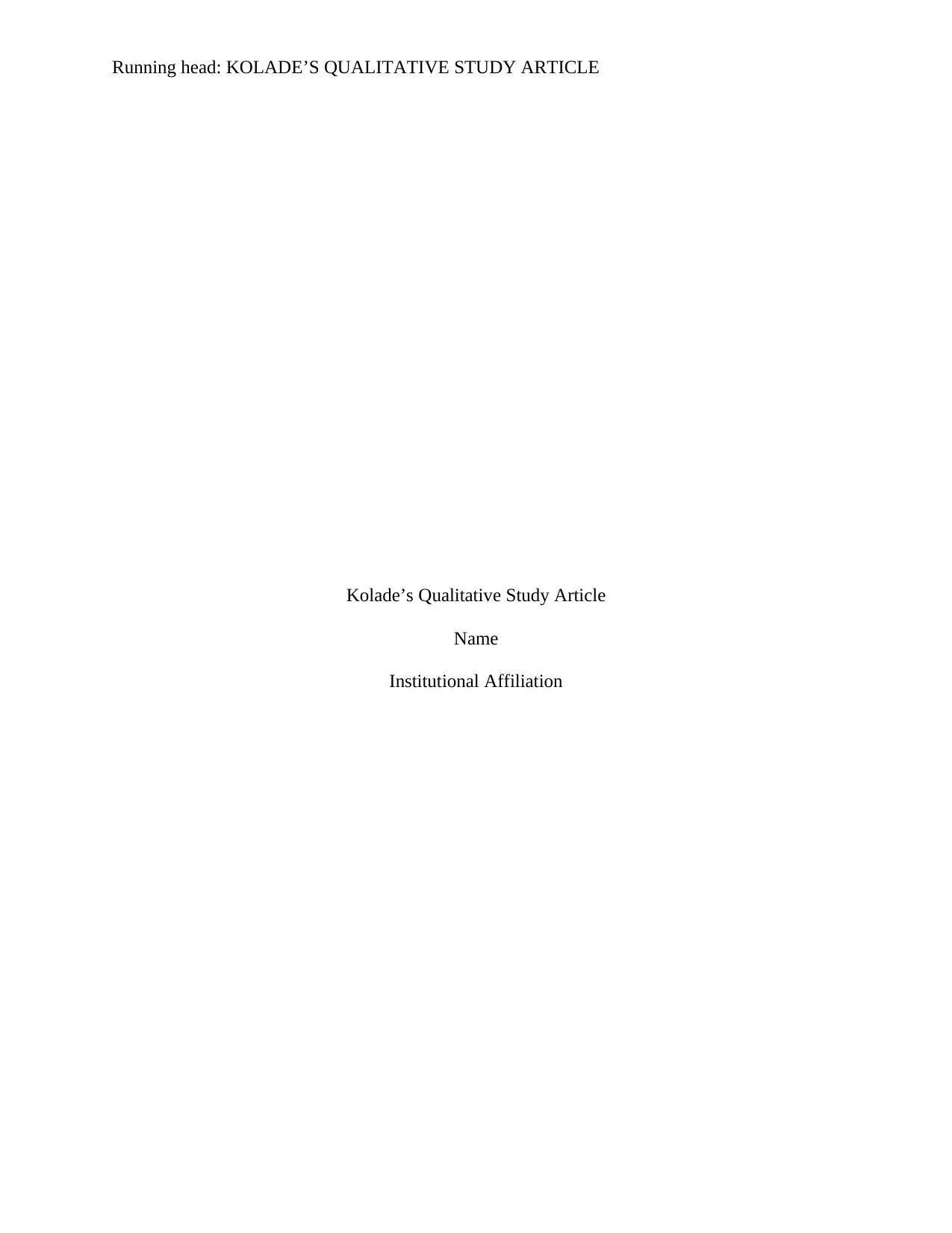
Running head: KOLADE’S QUALITATIVE STUDY ARTICLE
Kolade’s Qualitative Study Article
Name
Institutional Affiliation
Kolade’s Qualitative Study Article
Name
Institutional Affiliation
Paraphrase This Document
Need a fresh take? Get an instant paraphrase of this document with our AI Paraphraser
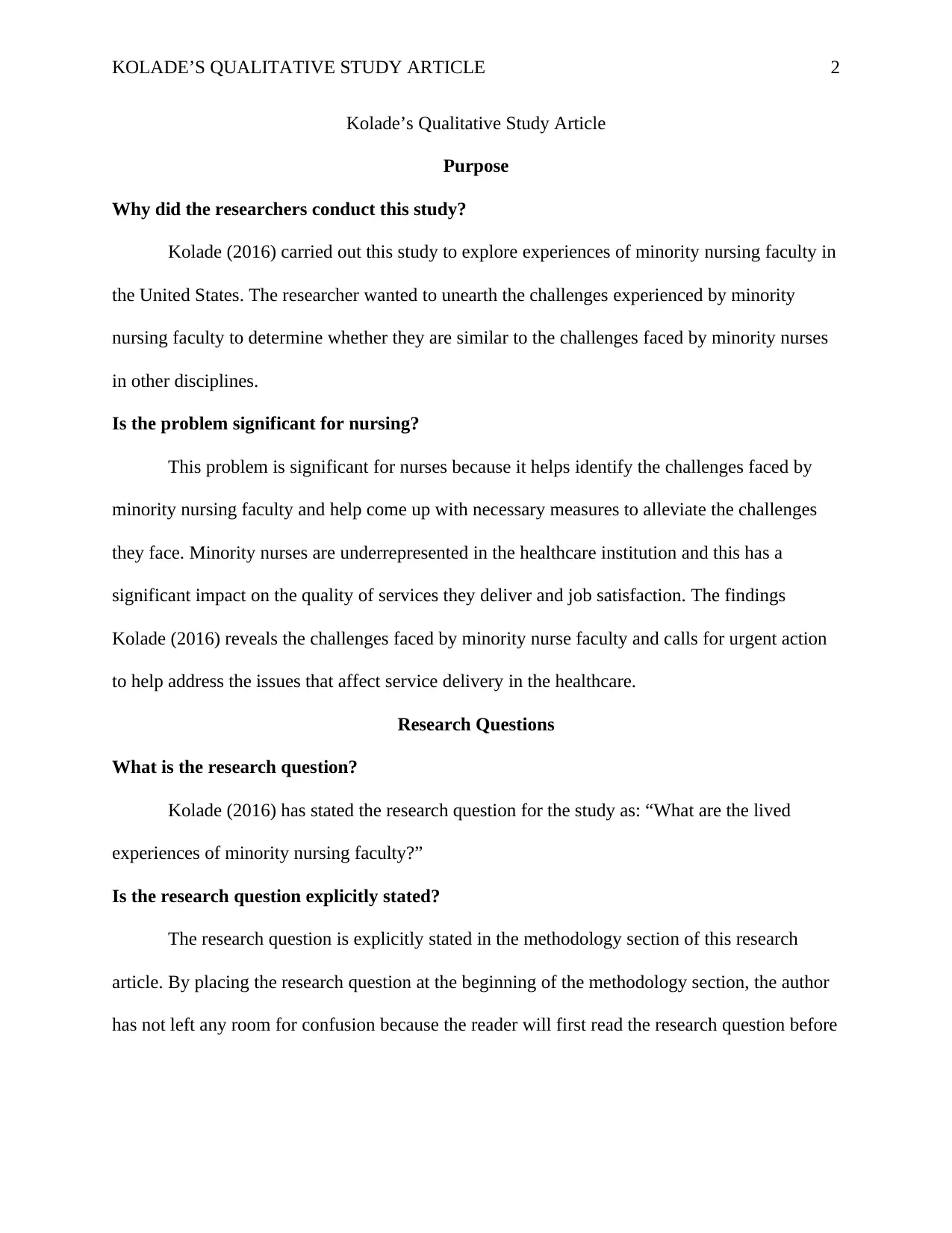
KOLADE’S QUALITATIVE STUDY ARTICLE 2
Kolade’s Qualitative Study Article
Purpose
Why did the researchers conduct this study?
Kolade (2016) carried out this study to explore experiences of minority nursing faculty in
the United States. The researcher wanted to unearth the challenges experienced by minority
nursing faculty to determine whether they are similar to the challenges faced by minority nurses
in other disciplines.
Is the problem significant for nursing?
This problem is significant for nurses because it helps identify the challenges faced by
minority nursing faculty and help come up with necessary measures to alleviate the challenges
they face. Minority nurses are underrepresented in the healthcare institution and this has a
significant impact on the quality of services they deliver and job satisfaction. The findings
Kolade (2016) reveals the challenges faced by minority nurse faculty and calls for urgent action
to help address the issues that affect service delivery in the healthcare.
Research Questions
What is the research question?
Kolade (2016) has stated the research question for the study as: “What are the lived
experiences of minority nursing faculty?”
Is the research question explicitly stated?
The research question is explicitly stated in the methodology section of this research
article. By placing the research question at the beginning of the methodology section, the author
has not left any room for confusion because the reader will first read the research question before
Kolade’s Qualitative Study Article
Purpose
Why did the researchers conduct this study?
Kolade (2016) carried out this study to explore experiences of minority nursing faculty in
the United States. The researcher wanted to unearth the challenges experienced by minority
nursing faculty to determine whether they are similar to the challenges faced by minority nurses
in other disciplines.
Is the problem significant for nursing?
This problem is significant for nurses because it helps identify the challenges faced by
minority nursing faculty and help come up with necessary measures to alleviate the challenges
they face. Minority nurses are underrepresented in the healthcare institution and this has a
significant impact on the quality of services they deliver and job satisfaction. The findings
Kolade (2016) reveals the challenges faced by minority nurse faculty and calls for urgent action
to help address the issues that affect service delivery in the healthcare.
Research Questions
What is the research question?
Kolade (2016) has stated the research question for the study as: “What are the lived
experiences of minority nursing faculty?”
Is the research question explicitly stated?
The research question is explicitly stated in the methodology section of this research
article. By placing the research question at the beginning of the methodology section, the author
has not left any room for confusion because the reader will first read the research question before
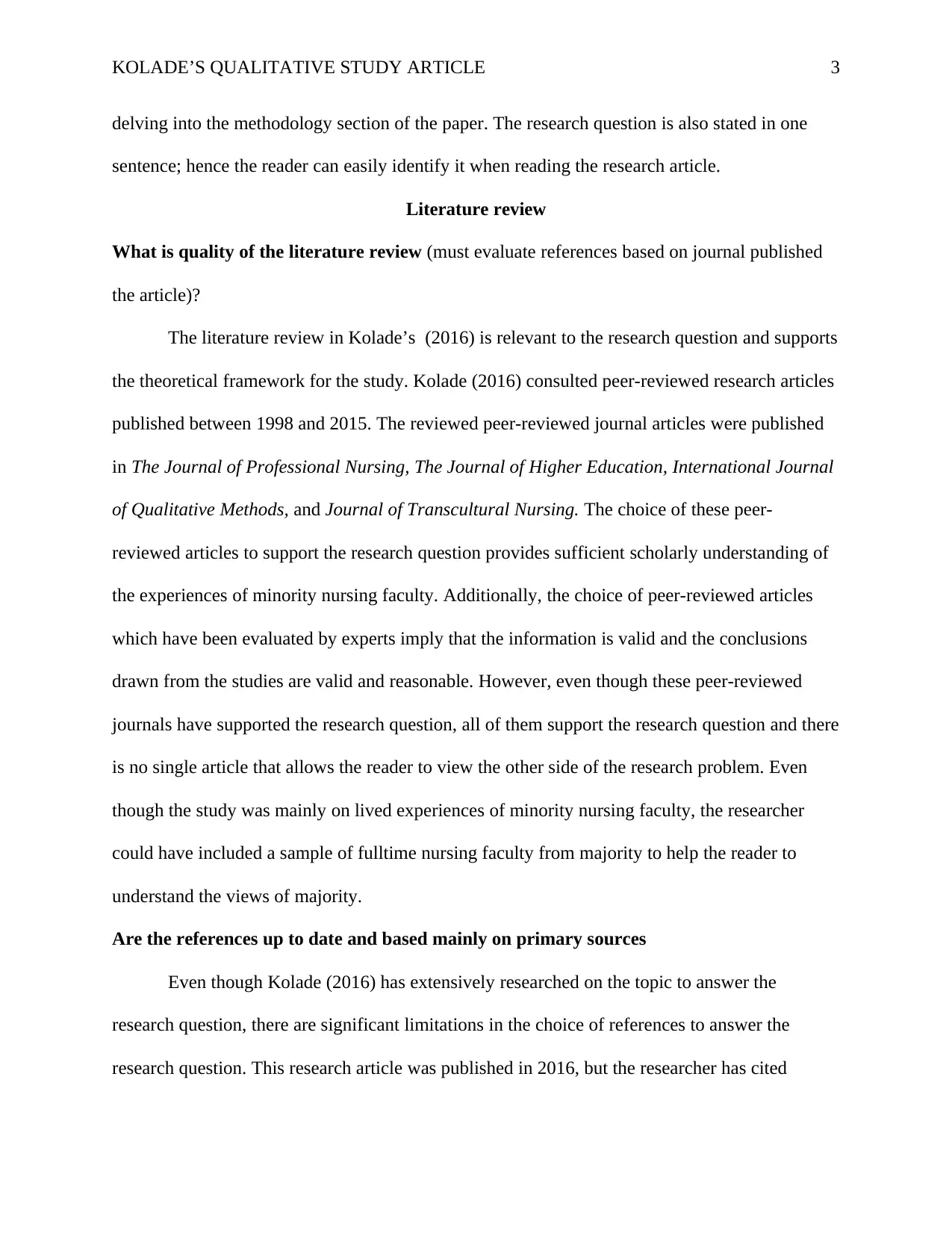
KOLADE’S QUALITATIVE STUDY ARTICLE 3
delving into the methodology section of the paper. The research question is also stated in one
sentence; hence the reader can easily identify it when reading the research article.
Literature review
What is quality of the literature review (must evaluate references based on journal published
the article)?
The literature review in Kolade’s (2016) is relevant to the research question and supports
the theoretical framework for the study. Kolade (2016) consulted peer-reviewed research articles
published between 1998 and 2015. The reviewed peer-reviewed journal articles were published
in The Journal of Professional Nursing, The Journal of Higher Education, International Journal
of Qualitative Methods, and Journal of Transcultural Nursing. The choice of these peer-
reviewed articles to support the research question provides sufficient scholarly understanding of
the experiences of minority nursing faculty. Additionally, the choice of peer-reviewed articles
which have been evaluated by experts imply that the information is valid and the conclusions
drawn from the studies are valid and reasonable. However, even though these peer-reviewed
journals have supported the research question, all of them support the research question and there
is no single article that allows the reader to view the other side of the research problem. Even
though the study was mainly on lived experiences of minority nursing faculty, the researcher
could have included a sample of fulltime nursing faculty from majority to help the reader to
understand the views of majority.
Are the references up to date and based mainly on primary sources
Even though Kolade (2016) has extensively researched on the topic to answer the
research question, there are significant limitations in the choice of references to answer the
research question. This research article was published in 2016, but the researcher has cited
delving into the methodology section of the paper. The research question is also stated in one
sentence; hence the reader can easily identify it when reading the research article.
Literature review
What is quality of the literature review (must evaluate references based on journal published
the article)?
The literature review in Kolade’s (2016) is relevant to the research question and supports
the theoretical framework for the study. Kolade (2016) consulted peer-reviewed research articles
published between 1998 and 2015. The reviewed peer-reviewed journal articles were published
in The Journal of Professional Nursing, The Journal of Higher Education, International Journal
of Qualitative Methods, and Journal of Transcultural Nursing. The choice of these peer-
reviewed articles to support the research question provides sufficient scholarly understanding of
the experiences of minority nursing faculty. Additionally, the choice of peer-reviewed articles
which have been evaluated by experts imply that the information is valid and the conclusions
drawn from the studies are valid and reasonable. However, even though these peer-reviewed
journals have supported the research question, all of them support the research question and there
is no single article that allows the reader to view the other side of the research problem. Even
though the study was mainly on lived experiences of minority nursing faculty, the researcher
could have included a sample of fulltime nursing faculty from majority to help the reader to
understand the views of majority.
Are the references up to date and based mainly on primary sources
Even though Kolade (2016) has extensively researched on the topic to answer the
research question, there are significant limitations in the choice of references to answer the
research question. This research article was published in 2016, but the researcher has cited
⊘ This is a preview!⊘
Do you want full access?
Subscribe today to unlock all pages.

Trusted by 1+ million students worldwide
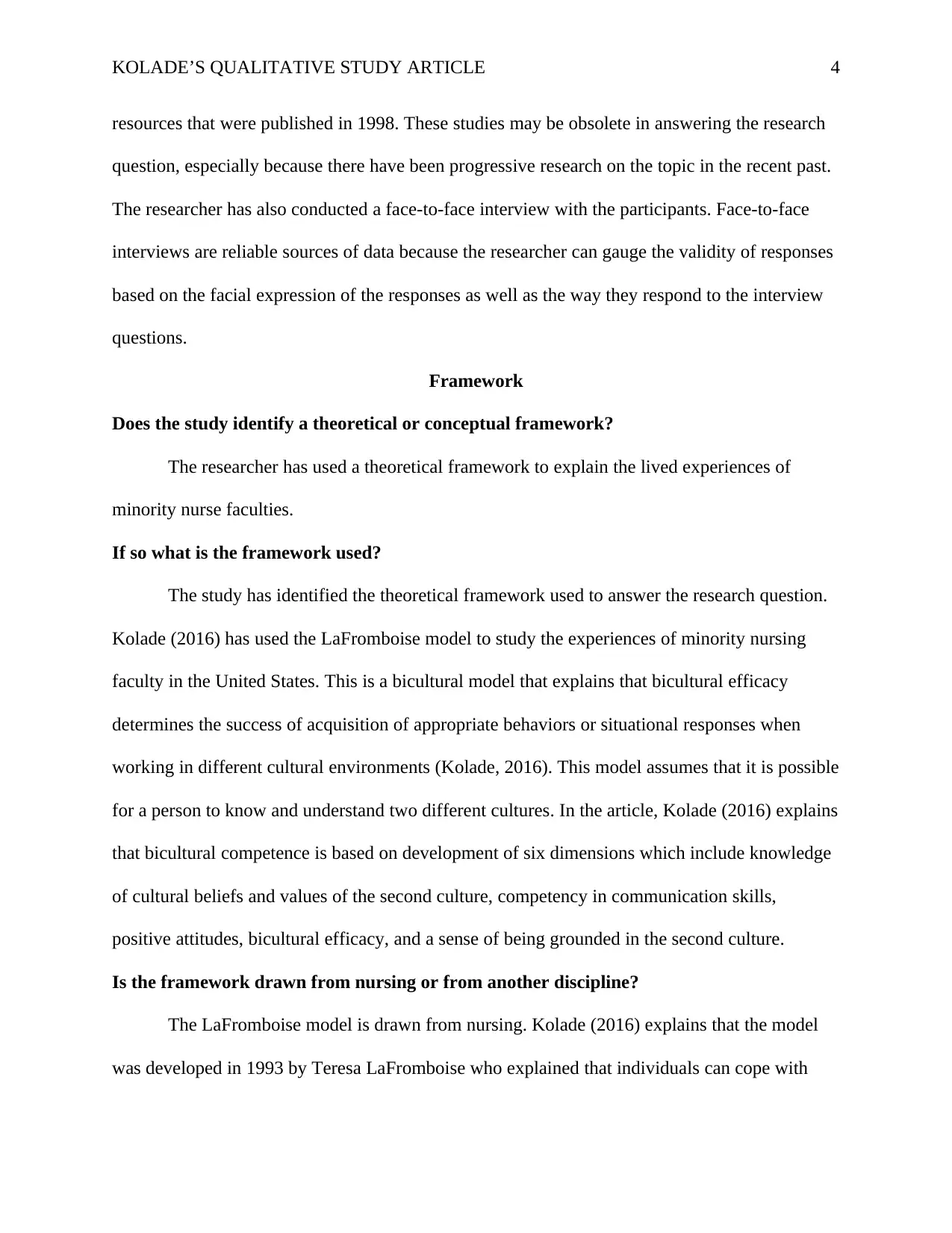
KOLADE’S QUALITATIVE STUDY ARTICLE 4
resources that were published in 1998. These studies may be obsolete in answering the research
question, especially because there have been progressive research on the topic in the recent past.
The researcher has also conducted a face-to-face interview with the participants. Face-to-face
interviews are reliable sources of data because the researcher can gauge the validity of responses
based on the facial expression of the responses as well as the way they respond to the interview
questions.
Framework
Does the study identify a theoretical or conceptual framework?
The researcher has used a theoretical framework to explain the lived experiences of
minority nurse faculties.
If so what is the framework used?
The study has identified the theoretical framework used to answer the research question.
Kolade (2016) has used the LaFromboise model to study the experiences of minority nursing
faculty in the United States. This is a bicultural model that explains that bicultural efficacy
determines the success of acquisition of appropriate behaviors or situational responses when
working in different cultural environments (Kolade, 2016). This model assumes that it is possible
for a person to know and understand two different cultures. In the article, Kolade (2016) explains
that bicultural competence is based on development of six dimensions which include knowledge
of cultural beliefs and values of the second culture, competency in communication skills,
positive attitudes, bicultural efficacy, and a sense of being grounded in the second culture.
Is the framework drawn from nursing or from another discipline?
The LaFromboise model is drawn from nursing. Kolade (2016) explains that the model
was developed in 1993 by Teresa LaFromboise who explained that individuals can cope with
resources that were published in 1998. These studies may be obsolete in answering the research
question, especially because there have been progressive research on the topic in the recent past.
The researcher has also conducted a face-to-face interview with the participants. Face-to-face
interviews are reliable sources of data because the researcher can gauge the validity of responses
based on the facial expression of the responses as well as the way they respond to the interview
questions.
Framework
Does the study identify a theoretical or conceptual framework?
The researcher has used a theoretical framework to explain the lived experiences of
minority nurse faculties.
If so what is the framework used?
The study has identified the theoretical framework used to answer the research question.
Kolade (2016) has used the LaFromboise model to study the experiences of minority nursing
faculty in the United States. This is a bicultural model that explains that bicultural efficacy
determines the success of acquisition of appropriate behaviors or situational responses when
working in different cultural environments (Kolade, 2016). This model assumes that it is possible
for a person to know and understand two different cultures. In the article, Kolade (2016) explains
that bicultural competence is based on development of six dimensions which include knowledge
of cultural beliefs and values of the second culture, competency in communication skills,
positive attitudes, bicultural efficacy, and a sense of being grounded in the second culture.
Is the framework drawn from nursing or from another discipline?
The LaFromboise model is drawn from nursing. Kolade (2016) explains that the model
was developed in 1993 by Teresa LaFromboise who explained that individuals can cope with
Paraphrase This Document
Need a fresh take? Get an instant paraphrase of this document with our AI Paraphraser
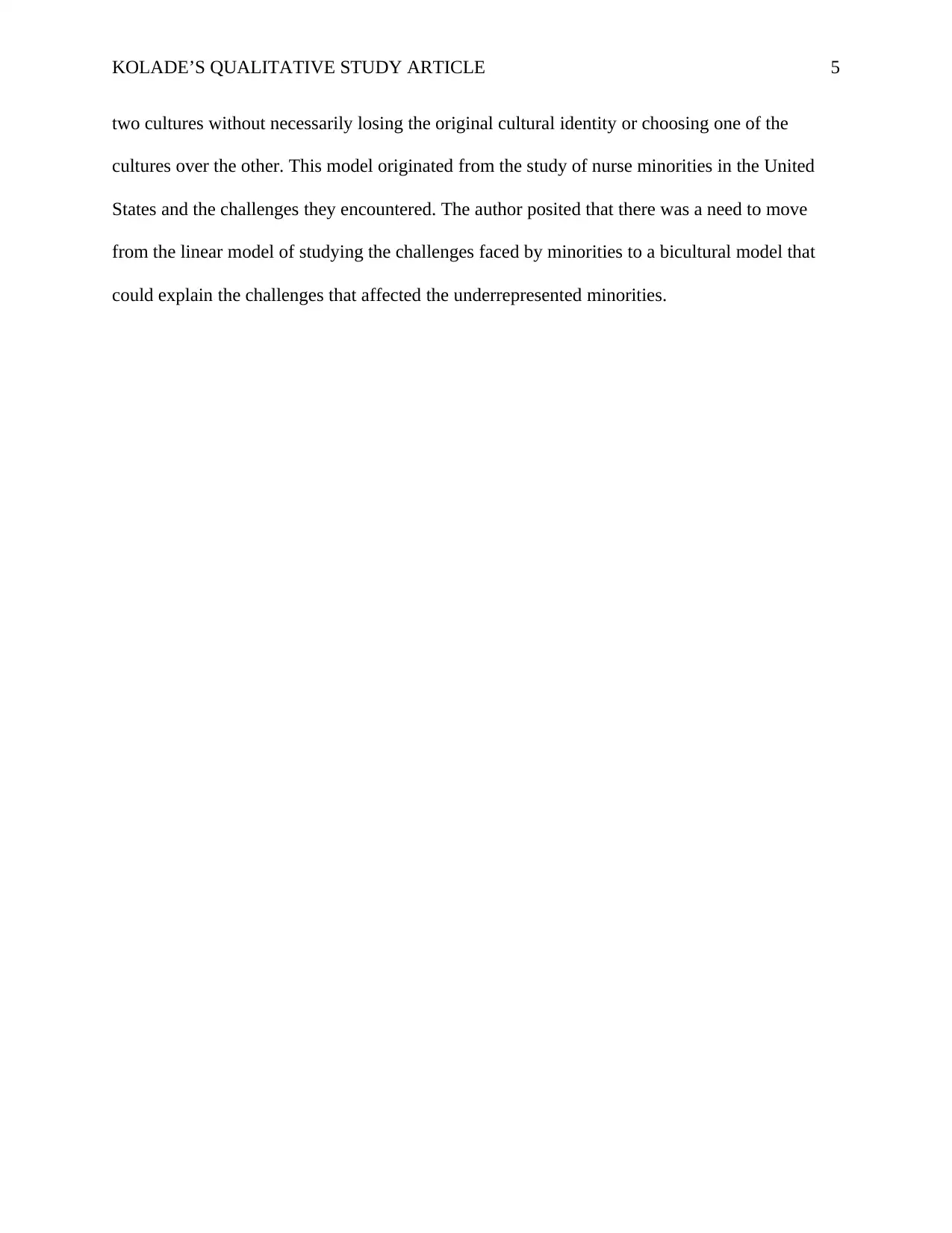
KOLADE’S QUALITATIVE STUDY ARTICLE 5
two cultures without necessarily losing the original cultural identity or choosing one of the
cultures over the other. This model originated from the study of nurse minorities in the United
States and the challenges they encountered. The author posited that there was a need to move
from the linear model of studying the challenges faced by minorities to a bicultural model that
could explain the challenges that affected the underrepresented minorities.
two cultures without necessarily losing the original cultural identity or choosing one of the
cultures over the other. This model originated from the study of nurse minorities in the United
States and the challenges they encountered. The author posited that there was a need to move
from the linear model of studying the challenges faced by minorities to a bicultural model that
could explain the challenges that affected the underrepresented minorities.
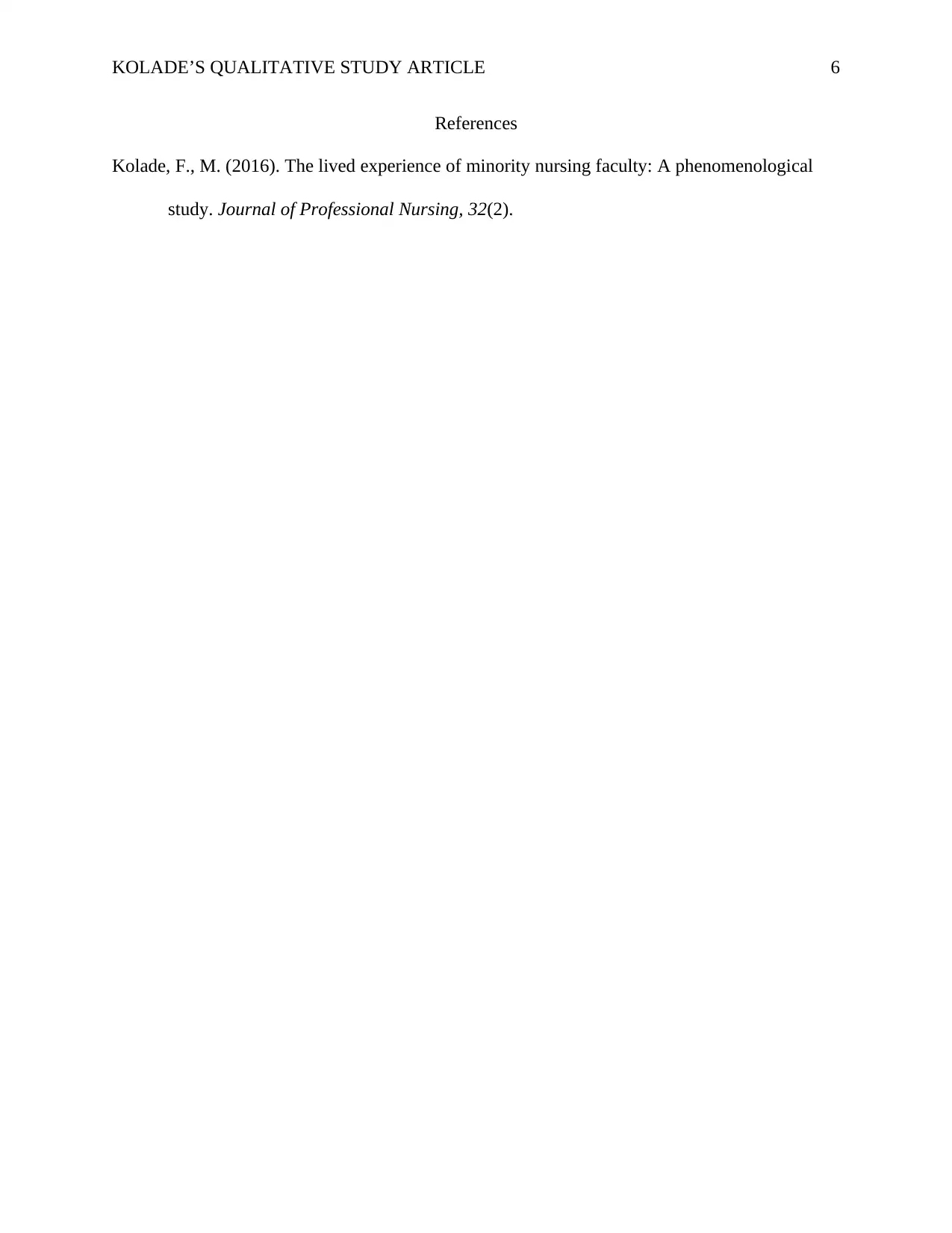
KOLADE’S QUALITATIVE STUDY ARTICLE 6
References
Kolade, F., M. (2016). The lived experience of minority nursing faculty: A phenomenological
study. Journal of Professional Nursing, 32(2).
References
Kolade, F., M. (2016). The lived experience of minority nursing faculty: A phenomenological
study. Journal of Professional Nursing, 32(2).
⊘ This is a preview!⊘
Do you want full access?
Subscribe today to unlock all pages.

Trusted by 1+ million students worldwide
1 out of 6
Related Documents
Your All-in-One AI-Powered Toolkit for Academic Success.
+13062052269
info@desklib.com
Available 24*7 on WhatsApp / Email
![[object Object]](/_next/static/media/star-bottom.7253800d.svg)
Unlock your academic potential
Copyright © 2020–2025 A2Z Services. All Rights Reserved. Developed and managed by ZUCOL.





